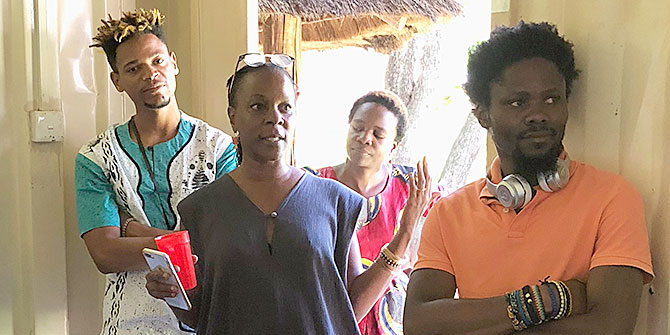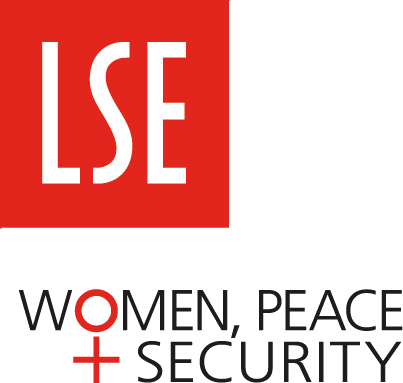Gloria Kiconco explores the multiplicity of what it means for displaced people and refugees to return home.
This article is part of our #LSEReturn series, exploring themes around Displacement and Return.
I am a Ugandan writer; specifically a poet, essayist, and an arts and culture journalist.
Here is where I join the Politics of Return research project.
It is a few minutes past midday on June 19 2018 when I arrive at 32 Degrees East|Ugandan Arts Trust. I join the gathered group of writers and filmmakers and visual artists and storytellers. Today we are meeting the artists-in-residence under the Politics of Return research project in partnership with the Kampala Contemporary Art Festival, KLA ART ’18.
Gael Kusa Kusa Maski is in the studio closest at hand, so we enter. We shuffle to fit in the narrow studio that was once a shipping container. I sit on the floor, below the makeshift white screen upon which he projects his work and the story of the family that inspired his Young Congo series. His rich collaged portraits reflect the layered lives of this Congolese family who make a living at a stone quarry. He translates each portrait in a collection of materials into a collage of complexities. An encounter with a person is absorbed into a collection of memories that he describes as “Un conglomérat d’Histoires.”
In an identical studio on the opposite side of the compound, Bathsheba Okwenje guides us through her work: Nile Mansions Hotel, an archive that places a young girl’s life at the centre of Uganda’s history; Mother, an installation where the walls whisper the experience of the interior life of a mother of five; and Adda Baazi, life-size images of women doing everyday things in male-dominated spaces in Delhi, India. She deconstructs a whole into individual materials or builds something new from lone objects. She pulls apart a whole to tell a story from the pieces left or the pieces not found.

In the final studio, above the library, we gather around Willy Karekezi who shows us a varied collection of paintings. In Willy’s paintings, different realities emerge, a simple but realistic foreground, a complex and surreal background. A stoic reality shown in the landscape of homes across hills, a longing for something more in the luminous and mysterious sky. He paints on canvas, on wood, on walls, on bodies. He paints on the same surface where another artist is painting. He surrenders space to another’s vision.
This is where they join the Politics of Return research project.
Gael Kusa Kusa Maski, Bathsheba Okwenje, and Willy Karekezi were selected for the imagination and empathy needed to interpret the research produced from the Politics of Return researchers into an accessible medium for those that actually endure said politics: the refugees, displaced persons, and returnees in East and Central Africa.
Gael Kusa Kusa Maski from the Democratic Republic of Congo, Bathsheba Okwenje from Uganda, and Willy Karekezi from Rwanda will dialogue with the researchers working on the Politics of Return research project which focus, in particular, on Central African Republic (CAR), Democratic Republic of Congo (DRC), South Sudan and Northern Uganda.
About 1 in 122 people on the globe are refugees, displaced, or seeking asylum. About 86 per cent of refugees live in developing countries. Some of these countries are Uganda, DRC, and CAR. They have a right to return home. Yet, returning and reintegrating is not that simple.
Refugees and displaced people are at the centre of the Politics of Return research project as international bodies seek to send them home, or they forge their own way home, or are rejected from other countries and told to go back home. In some cases, they cross back home every day, or every few years until a new war ejects them from their home. As the researchers seeking a better understanding of the complexities of what it means to return, the artists visually re-imagine these narratives and render the research accessible for returnees. I am one of a group of writers following the artists’ journey of interpreting the multiple realities of the displaced and refugees.
Here is where we pause and reflect on what it means to return.
Do refugees go home or come home?
What is does it mean to tell someone “come home”?
What does it mean to tell them “go home”?
What does it mean to return every day?
Back and forth across the border of Uganda and DRC?
At home by day, a refugee by night.
For the Acholi children born in IDP camps,
what does it mean to return home?
When home is a place kilometres away.
When home is a place to which they have never been.
What do they imagine when others speak of going home?
What does it mean, in South Sudan, to return home?
When home is constantly changing hands.
If you are an integral part of the vision,
the nostalgia of home as you remember it,
can you ever “come” home
if you change?
Here is where we change the narrative.
I could be a Muslim woman recently returned to CAR, confined to the Bangui neighborhood of PK5 and hiding my veil if I venture out of this close community. I could be Juliet, born in an IDP camp in Northern Uganda, out of rhythm with the rest of society after the war because my existence was for so long holding its breath. I could be Chol, who had to leave Rubkuany in South Sudan to protect his wife and reassert his position as husband and father. Chol, who is a refugee, but also doing research at LSE. Research on people like him and me. Who return to a place that has changed and we are changed. Who cannot fill the space left by displacement.
They write theories about us. Artists create work about us. About what the researchers report on us.
Like Willy Karekezi, the painter from Kigali, who painted murals in refugee settlements. Who makes a gallery of his neighbourhood and brings art into the nearby homes. Or Bathsheba Okwenje, who lives in Fort Portal in Western Uganda. Who worked for the UN and has seen us as statistics. Who worked through a camera lens and has seen us as individuals. Or Gael Kusa Kusa Maski, who knows what it means to flee your home. Who had to flee from eastern DRC. Who has learned to live with multiple realities. Willy, Bathsheba, and Gael, who are from the countries we run to and run from.
Rwanda, Uganda, Congo. Rwanda, Uganda, Congo. Rwanda, Uganda, Congo.
One day we will see ourselves in their creations. Something beautiful made of our complex selves. And scribes will write about them and about the research and about us. About how we can go home and we can return, but it does not always mean that we have come home.
Find out more about the Politics of Return and our Trajectories of Displacement research projects, which are based at the Firoz Lalji Centre for Africa and funded by ESRC/AHRC.
Gloria Kiconco (@GKiconco) is a poet, essayist, and zine-maker based in Kampala, Uganda. She regularly writes about arts and culture in East Africa and performs spoken word poetry around Kampala. You can follow her work at otherandelse.wordpress.com.
The views expressed in this post are those of the author and in no way reflect those of the Africa at LSE blog, the Firoz Lalji Centre for Africa or the London School of Economics and Political Science.





